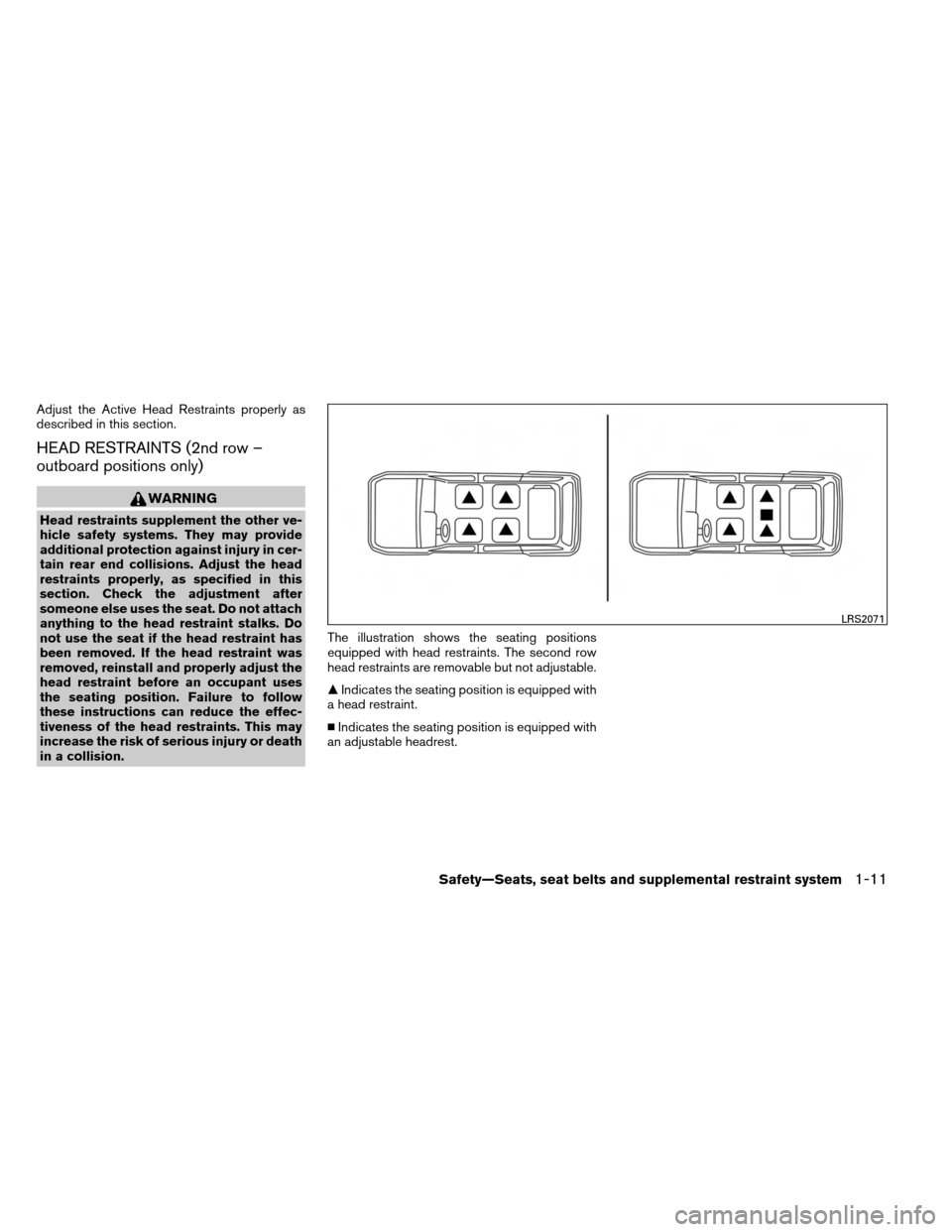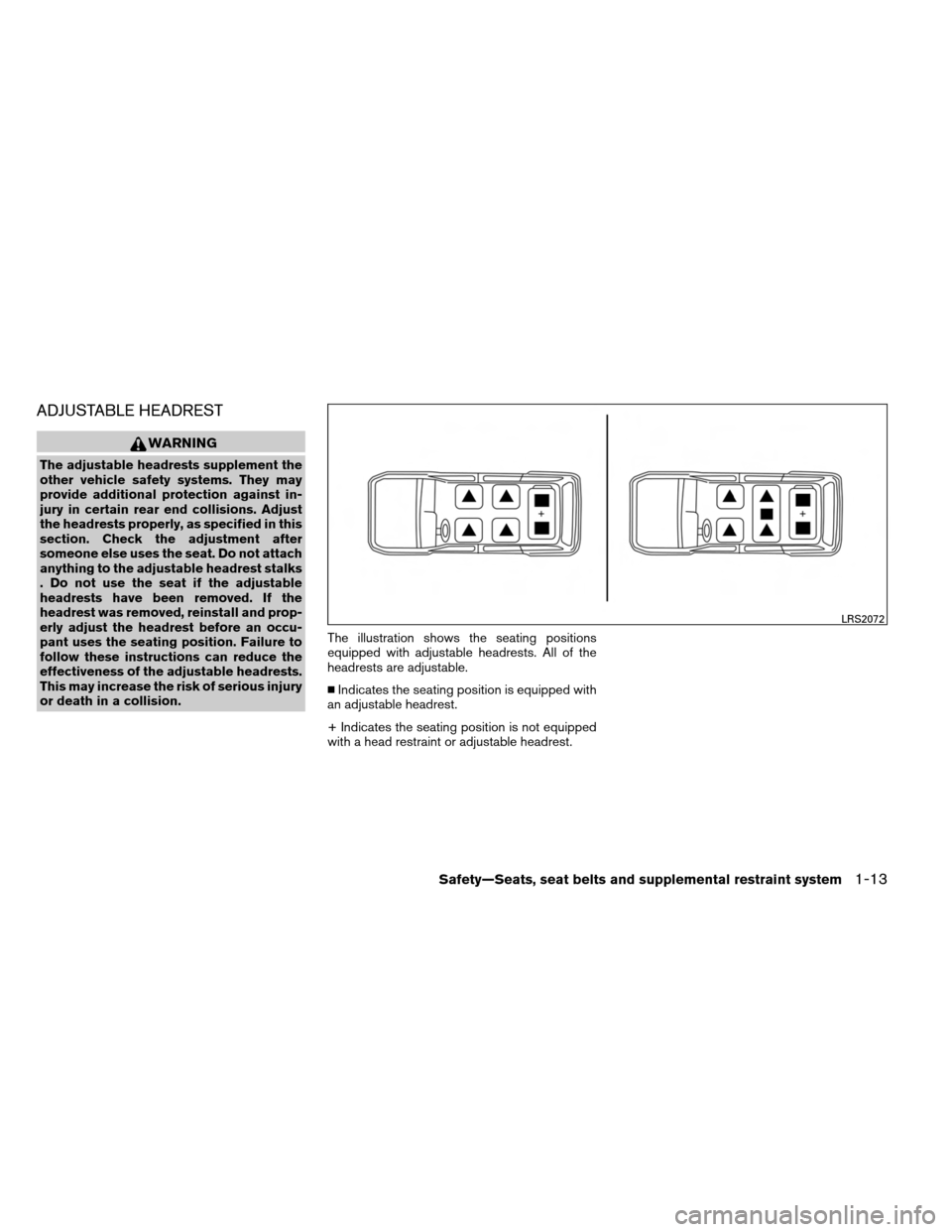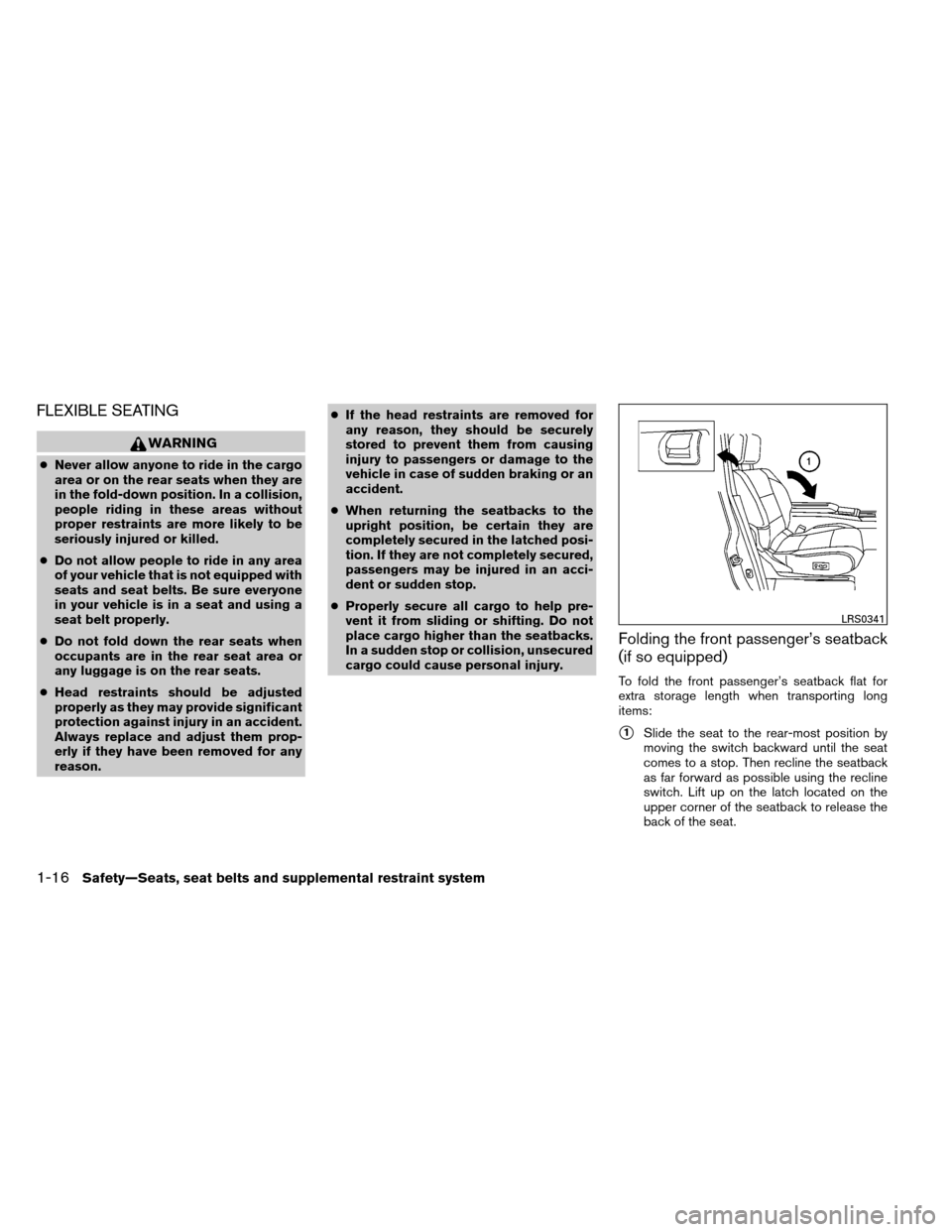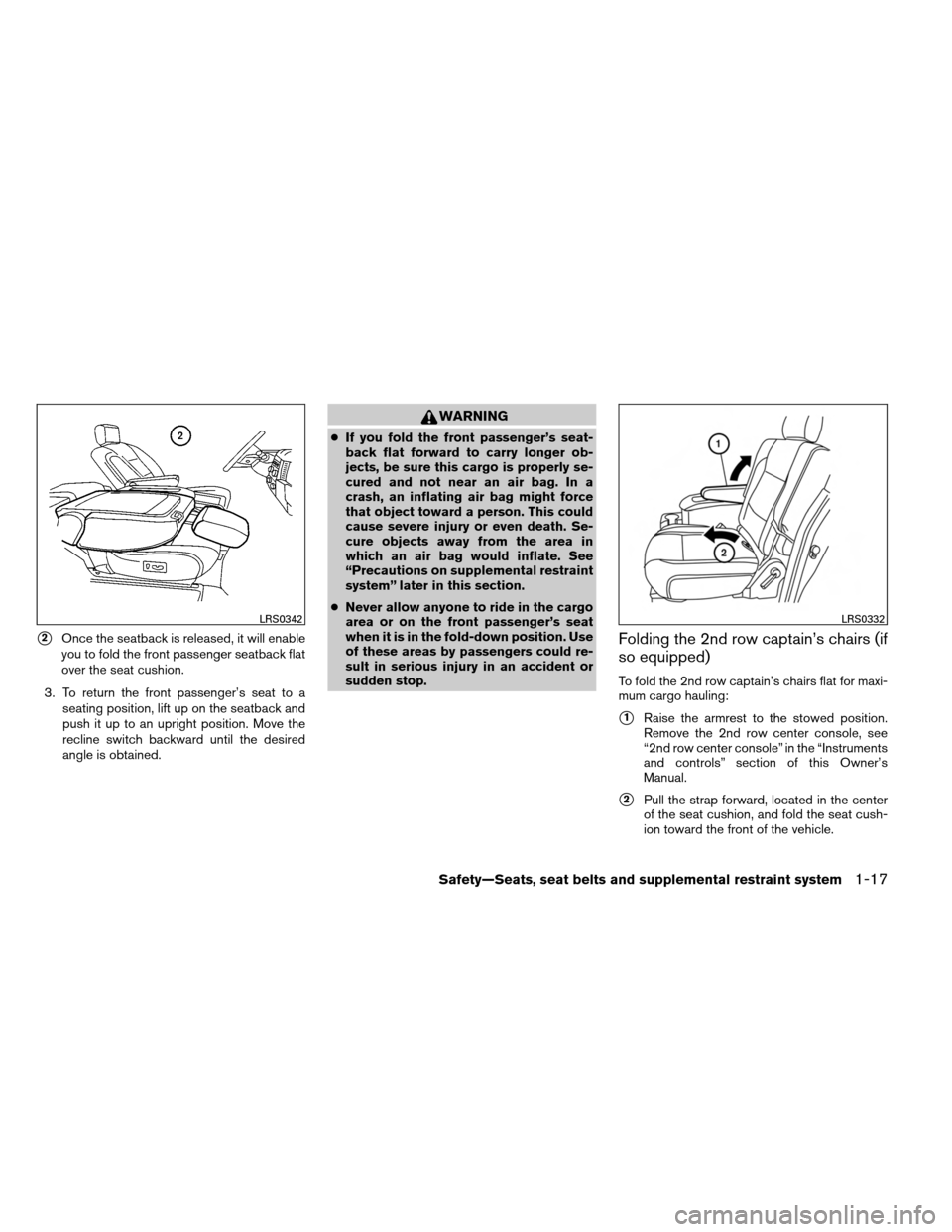Page 24 of 489
ARMRESTS
To use the armrests, pull them down to the rest-
ing position.
�AStowed position
�BResting position
HEAD RESTRAINTS (1st row only)
WARNING
Head restraints supplement the other ve-
hicle safety systems. They may provide
additional protection against injury in cer-
tain rear end collisions. Adjust the head
restraints properly, as specified in this
section. Check the adjustment after
someone else uses the seat. Do not attach
anything to the head restraint stalks. Do
not use the seat if the head restraint has
been removed. If the head restraint was
removed, reinstall and properly adjust the
head restraint before an occupant uses
the seating position. Failure to follow
these instructions can reduce the effec-
tiveness of the head restraints. This may
increase the risk of serious injury or death
in a collision.
WRS0368
Safety—Seats, seat belts and supplemental restraint system1-7
Page 27 of 489

Removal
Use the following procedure to remove the ad-
justable head restraints.1. Pull the head restraint up to the highest position.
2. Push and hold the lock knob.
3. Remove the head restraint from the seat.
4. Store the head restraint properly so it is not loose in the vehicle.
5. Reinstall and properly adjust the head re- straint before an occupant uses the seating
position.
Install
1. Align the head restraint stalks with the holesin the seat. Make sure the head restraint is
facing the correct direction. The stalk with
the adjustment notches
�1must be installed
in the hole with the lock knob
�2.
2. Push and hold the lock knob and push the head restraint down.
3. Properly adjust the head restraint before an occupant uses the seating position.
Front-seat Active Head Restraints
The Active Head Restraint moves forward utiliz-
ing the force that the seatback receives from the
occupant in a rear-end collision. The movement
of the head restraint helps support the occu-
pant’s head by reducing its backward movement
and helping absorb some of the forces that may
lead to whiplash-type injuries.
Active Head Restraints are effective for collisions
at low to medium speeds in which it is said that
whiplash injury occurs most.
Active Head Restraints operate only in certain
rear-end collisions. After the collision, the head
restraints return to their original position.
LRS0890LRS0891SPA1025
1-10Safety—Seats, seat belts and supplemental restraint system
Page 28 of 489

Adjust the Active Head Restraints properly as
described in this section.
HEAD RESTRAINTS (2nd row –
outboard positions only)
WARNING
Head restraints supplement the other ve-
hicle safety systems. They may provide
additional protection against injury in cer-
tain rear end collisions. Adjust the head
restraints properly, as specified in this
section. Check the adjustment after
someone else uses the seat. Do not attach
anything to the head restraint stalks. Do
not use the seat if the head restraint has
been removed. If the head restraint was
removed, reinstall and properly adjust the
head restraint before an occupant uses
the seating position. Failure to follow
these instructions can reduce the effec-
tiveness of the head restraints. This may
increase the risk of serious injury or death
in a collision.The illustration shows the seating positions
equipped with head restraints. The second row
head restraints are removable but not adjustable.
�
Indicates the seating position is equipped with
a head restraint.
� Indicates the seating position is equipped with
an adjustable headrest.
LRS2071
Safety—Seats, seat belts and supplemental restraint system1-11
Page 29 of 489
Components
1. Head restraint
2. Lock knob
3. Stalks
Removal
Use the following procedure to remove the head
restraints.1. Adjust the seat or seatback as necessary.
2. Push and hold the lock knob(s) .
3. Pull the head restraint up until it is removed from the seat.
4. Store the head restraint properly so it is not loose in the vehicle.
5. Reinstall the head restraint and properly ad- just the seat or seatback before an occupant
uses the seating position.
Install
1. Align the head restraint stalks with the holes
in the seat. Make sure the head restraint is
facing the correct direction.
2. Push the head restraint down until it locks in place.
LRS2073LRS2074LRS2075
1-12Safety—Seats, seat belts and supplemental restraint system
Page 30 of 489

ADJUSTABLE HEADREST
WARNING
The adjustable headrests supplement the
other vehicle safety systems. They may
provide additional protection against in-
jury in certain rear end collisions. Adjust
the headrests properly, as specified in this
section. Check the adjustment after
someone else uses the seat. Do not attach
anything to the adjustable headrest stalks
. Do not use the seat if the adjustable
headrests have been removed. If the
headrest was removed, reinstall and prop-
erly adjust the headrest before an occu-
pant uses the seating position. Failure to
follow these instructions can reduce the
effectiveness of the adjustable headrests.
This may increase the risk of serious injury
or death in a collision.The illustration shows the seating positions
equipped with adjustable headrests. All of the
headrests are adjustable.
�
Indicates the seating position is equipped with
an adjustable headrest.
+ Indicates the seating position is not equipped
with a head restraint or adjustable headrest.
LRS2072
Safety—Seats, seat belts and supplemental restraint system1-13
Page 32 of 489
To lower, push and hold the lock knob and push
the headrest down.Removal
Use the following procedure to remove the ad-
justable headrests.1. Pull the headrest up to the highest position.
2. Push and hold the lock knob.
3. Remove the headrest from the seat.
4. Store the headrest properly so it is not loose in the vehicle.
5. Reinstall and properly adjust the headrest before an occupant uses the seating posi-
tion.
Install
1. Align the headrest stalks with the holes inthe seat. Make sure the headrest is facing
the correct direction. The stalk with the ad-
justment notches
�1must be installed in the
hole with the lock knob
�2.
2. Push and hold the lock knob and push the headrest down.
3. Properly adjust the headrest before an oc- cupant uses the seating position.
LRS0889LRS0890LRS0891
Safety—Seats, seat belts and supplemental restraint system1-15
Page 33 of 489

FLEXIBLE SEATING
WARNING
●Never allow anyone to ride in the cargo
area or on the rear seats when they are
in the fold-down position. In a collision,
people riding in these areas without
proper restraints are more likely to be
seriously injured or killed.
● Do not allow people to ride in any area
of your vehicle that is not equipped with
seats and seat belts. Be sure everyone
in your vehicle is in a seat and using a
seat belt properly.
● Do not fold down the rear seats when
occupants are in the rear seat area or
any luggage is on the rear seats.
● Head restraints should be adjusted
properly as they may provide significant
protection against injury in an accident.
Always replace and adjust them prop-
erly if they have been removed for any
reason. ●
If the head restraints are removed for
any reason, they should be securely
stored to prevent them from causing
injury to passengers or damage to the
vehicle in case of sudden braking or an
accident.
● When returning the seatbacks to the
upright position, be certain they are
completely secured in the latched posi-
tion. If they are not completely secured,
passengers may be injured in an acci-
dent or sudden stop.
● Properly secure all cargo to help pre-
vent it from sliding or shifting. Do not
place cargo higher than the seatbacks.
In a sudden stop or collision, unsecured
cargo could cause personal injury.
Folding the front passenger’s seatback
(if so equipped)
To fold the front passenger’s seatback flat for
extra storage length when transporting long
items:
�1Slide the seat to the rear-most position by
moving the switch backward until the seat
comes to a stop. Then recline the seatback
as far forward as possible using the recline
switch. Lift up on the latch located on the
upper corner of the seatback to release the
back of the seat.
LRS0341
1-16Safety—Seats, seat belts and supplemental restraint system
Page 34 of 489

�2Once the seatback is released, it will enable
you to fold the front passenger seatback flat
over the seat cushion.
3. To return the front passenger’s seat to a seating position, lift up on the seatback and
push it up to an upright position. Move the
recline switch backward until the desired
angle is obtained.
WARNING
●If you fold the front passenger’s seat-
back flat forward to carry longer ob-
jects, be sure this cargo is properly se-
cured and not near an air bag. In a
crash, an inflating air bag might force
that object toward a person. This could
cause severe injury or even death. Se-
cure objects away from the area in
which an air bag would inflate. See
“Precautions on supplemental restraint
system” later in this section.
● Never allow anyone to ride in the cargo
area or on the front passenger’s seat
when it is in the fold-down position. Use
of these areas by passengers could re-
sult in serious injury in an accident or
sudden stop.
Folding the 2nd row captain’s chairs (if
so equipped)
To fold the 2nd row captain’s chairs flat for maxi-
mum cargo hauling:
�1Raise the armrest to the stowed position.
Remove the 2nd row center console, see
“2nd row center console” in the “Instruments
and controls” section of this Owner’s
Manual.
�2Pull the strap forward, located in the center
of the seat cushion, and fold the seat cush-
ion toward the front of the vehicle.
LRS0342LRS0332
Safety—Seats, seat belts and supplemental restraint system1-17